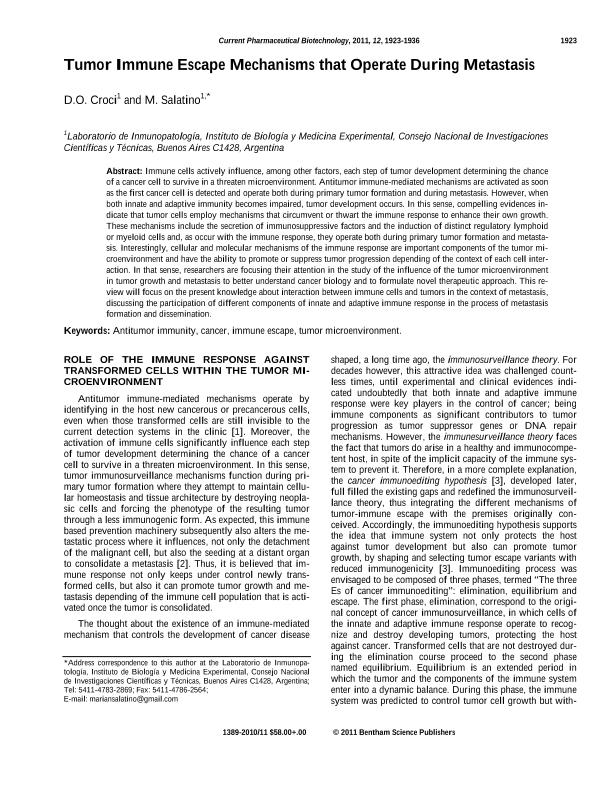Mostrar el registro sencillo del ítem
dc.contributor.author
Croci Russo, Diego Omar

dc.contributor.author
Salatino, Mariana

dc.date.available
2017-03-17T15:05:02Z
dc.date.issued
2011-04
dc.identifier.citation
Croci Russo, Diego Omar; Salatino, Mariana; Tumor immune escape mechanisms that operate during metastasis; Bentham Science Publishers; Current Pharmaceutical Biotechnology; 12; 11; 4-2011; 1923-1936
dc.identifier.issn
1389-2010
dc.identifier.uri
http://hdl.handle.net/11336/14011
dc.description.abstract
Immune cells actively influence, among other factors, each step of tumor development determining the chance of a cancer cell to survive in a threaten microenvironment. Antitumor immune-mediated mechanisms are activated as soon as the first cancer cell is detected and operate both during primary tumor formation and during metastasis. However, when both innate and adaptive immunity becomes impaired, tumor development occurs. In this sense, compelling evidences indicate that tumor cells employ mechanisms that circumvent or thwart the immune response to enhance their own growth. These mechanisms include the secretion of immunosuppressive factors and the induction of distinct regulatory lymphoid or myeloid cells and, as occur with the immune response, they operate both during primary tumor formation and metastasis. Interestingly, cellular and molecular mechanisms of the immune response are important components of the tumor microenvironment and have the ability to promote or suppress tumor progression depending of the context of each cell interaction. In that sense, researchers are focusing their attention in the study of the influence of the tumor microenvironment in tumor growth and metastasis to better understand cancer biology and to formulate novel therapeutic approach. This review will focus on the present knowledge about interaction between immune cells and tumors in the context of metastasis, discussing the participation of different components of innate and adaptive immune response in the process of metastasis formation and dissemination.
dc.format
application/pdf
dc.language.iso
eng
dc.publisher
Bentham Science Publishers

dc.rights
info:eu-repo/semantics/openAccess
dc.rights.uri
https://creativecommons.org/licenses/by-nc-sa/2.5/ar/
dc.subject
Metastasis
dc.subject
Galectins
dc.subject
Antitumor Immunity
dc.subject
Cancer
dc.subject
Mieloyd Cells
dc.subject.classification
Bioquímica y Biología Molecular

dc.subject.classification
Ciencias Biológicas

dc.subject.classification
CIENCIAS NATURALES Y EXACTAS

dc.subject.classification
Inmunología

dc.subject.classification
Medicina Básica

dc.subject.classification
CIENCIAS MÉDICAS Y DE LA SALUD

dc.title
Tumor immune escape mechanisms that operate during metastasis
dc.type
info:eu-repo/semantics/article
dc.type
info:ar-repo/semantics/artículo
dc.type
info:eu-repo/semantics/publishedVersion
dc.date.updated
2017-03-08T15:18:38Z
dc.identifier.eissn
1873-4316
dc.journal.volume
12
dc.journal.number
11
dc.journal.pagination
1923-1936
dc.journal.pais
Países Bajos

dc.journal.ciudad
Hilversum
dc.description.fil
Fil: Croci Russo, Diego Omar. Consejo Nacional de Investigaciones Científicas y Técnicas. Instituto de Biología y Medicina Experimental (i); Argentina
dc.description.fil
Fil: Salatino, Mariana. Consejo Nacional de Investigaciones Científicas y Técnicas. Instituto de Biología y Medicina Experimental (i); Argentina
dc.journal.title
Current Pharmaceutical Biotechnology

dc.relation.alternativeid
info:eu-repo/semantics/altIdentifier/url/http://www.eurekaselect.com/75846/article
dc.relation.alternativeid
info:eu-repo/semantics/altIdentifier/doi/http://dx.doi.org/10.2174/138920111798376987
Archivos asociados
